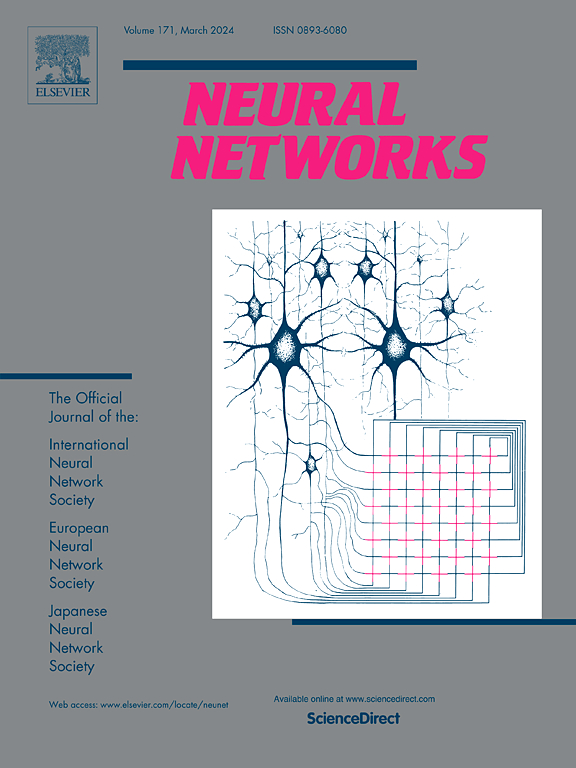ST-FlowNet: An efficient Spiking Neural Network for event-based optical flow estimation
IF 6
1区 计算机科学
Q1 COMPUTER SCIENCE, ARTIFICIAL INTELLIGENCE
引用次数: 0
Abstract
Spiking Neural Networks (SNNs) have emerged as a promising tool for event-based optical flow estimation tasks due to their capability for spatio-temporal information processing and low-power computation. However, the performance of SNN models is often constrained, limiting their applications in real-world scenarios. To address this challenge, we propose ST-FlowNet, a novel neural network architecture specifically designed for optical flow estimation from event-based data. The ST-FlowNet architecture integrates ConvGRU modules to facilitate cross-modal feature augmentation and temporal alignment of the predicted optical flow, thereby improving the network’s ability to capture complex motion patterns. Additionally, we introduce two strategies for deriving SNN models from pre-trained artificial neural networks (ANNs): a standard ANN-to-SNN conversion pipeline and our proposed BISNN method. Notably, the BISNN method alleviates the complexities involved in selecting biologically inspired parameters, further enhancing the robustness of SNNs for optical flow estimation tasks. Extensive evaluations on three benchmark event-based datasets demonstrate that the SNN-based ST-FlowNet model outperforms state-of-the-art methods, achieving superior accuracy in optical flow estimation across a diverse range of dynamic visual scenes. Furthermore, the energy efficiency of models also underscores the potential of SNNs for practical deployment in energy-constrained environments. Overall, our work presents a novel framework for optical flow estimation using SNNs and event-based data, contributing to the advancement of neuromorphic vision applications.
ST-FlowNet:一种高效的基于事件的光流估计尖峰神经网络
脉冲神经网络(SNNs)因其具有时空信息处理能力和低功耗计算能力而成为基于事件的光流估计任务的一种有前途的工具。然而,SNN模型的性能经常受到限制,限制了它们在现实场景中的应用。为了应对这一挑战,我们提出了ST-FlowNet,这是一种专门为基于事件数据的光流估计而设计的新型神经网络架构。ST-FlowNet架构集成了ConvGRU模块,以促进预测光流的跨模态特征增强和时间对齐,从而提高网络捕获复杂运动模式的能力。此外,我们还介绍了从预训练的人工神经网络(ann)中导出SNN模型的两种策略:标准的ann到SNN转换管道和我们提出的BISNN方法。值得注意的是,BISNN方法减轻了选择生物启发参数的复杂性,进一步增强了snn在光流估计任务中的鲁棒性。对三个基准事件数据集的广泛评估表明,基于snn的ST-FlowNet模型优于最先进的方法,在各种动态视觉场景的光流估计中实现了卓越的准确性。此外,模型的能源效率也强调了snn在能源受限环境中实际部署的潜力。总的来说,我们的工作提出了一个使用snn和基于事件的数据进行光流估计的新框架,有助于推进神经形态视觉的应用。
本文章由计算机程序翻译,如有差异,请以英文原文为准。
求助全文
约1分钟内获得全文
求助全文
来源期刊

Neural Networks
工程技术-计算机:人工智能
CiteScore
13.90
自引率
7.70%
发文量
425
审稿时长
67 days
期刊介绍:
Neural Networks is a platform that aims to foster an international community of scholars and practitioners interested in neural networks, deep learning, and other approaches to artificial intelligence and machine learning. Our journal invites submissions covering various aspects of neural networks research, from computational neuroscience and cognitive modeling to mathematical analyses and engineering applications. By providing a forum for interdisciplinary discussions between biology and technology, we aim to encourage the development of biologically-inspired artificial intelligence.
 求助内容:
求助内容: 应助结果提醒方式:
应助结果提醒方式:


